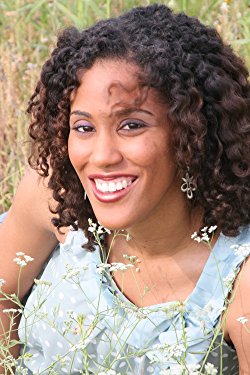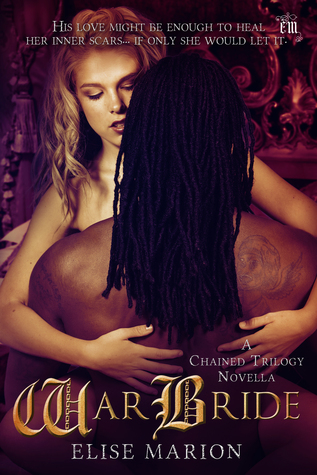 Elise Marion, author of the Chained series, was generous enough to do an interview with me in anticipation of our War Bride giveaway event. It’s a pleasure to be working with her and to have her on the blog. She has some great answers, including her opinion on the lack of diversity in books. I highly recommend you read her work, because she really is a fantastic writer.
Elise Marion, author of the Chained series, was generous enough to do an interview with me in anticipation of our War Bride giveaway event. It’s a pleasure to be working with her and to have her on the blog. She has some great answers, including her opinion on the lack of diversity in books. I highly recommend you read her work, because she really is a fantastic writer.
1) When did you know you wanted to write?
Since I was twelve years old. That was when I wrote my first book—sitting at a little desk in my room with a stack of notebook paper and a pencil, I would use a stopwatch to see how long I could write in one sitting.
I continued writing all through my middle and high school years, poetry mostly, but sometimes full-length stories, too.
2) What inspired the Chained Series?
In high school I discovered historical romance and fell in love. For years, it was the only thing I’d read.
But as I got older I began to recognize the lack of diversity in the genre. I love reading about the opulence and fashion of the difference eras, but almost never got to read about women who looked like me in those settings. As a black woman, I craved that diversity, and once I became published, decided that it was up to me to write what I wanted to see.
As a black woman, I craved that diversity, and once I became published, decided that it was up to me to write what I wanted to see.
A few years ago, I became a fan of Game of Thrones (both the show and the books), and became fascinated by the Medieval era. When I got the idea to write a Medieval era romance series centered around two feuding clans, I saw it as my chance to incorporate some diversity. What if one of the clans was made up of black people?
In my mind I saw this beautiful, fierce warrior princess, who just so happened to be black like me. I realized I’d never seen her written … not in a romance novel, anyway. I knew I had to make this story a reality.

3) Why do you write?
Honestly, I write because I can’t NOT write. The ideas are constantly coming to me, and the characters demand to have their voices heard. I’ve found that there are people looking for the types of stories that I write, so now that I’ve got a small but growing fan base, I also write for them.
4) What does a typical writing day look for you?
No two days are the same, because as a wife and mother of 3 kids, life itself is unpredictable. Two of my kids are in school, but the youngest still stays home with me all day.
I typically spend my mornings getting him up, fed, dressed, and settled with something to keep him occupied. Then there are emails to respond to, website to manage, social media, and a host of other things I have to prioritize for the business side of being self-published. I like to accomplish those things first, so that when I sit down to write, my mind is clear and I’m not thinking about other things that need to be done.
I try to write at least 2-3 hours a day, but of course that doesn’t always happen. Every now and then, I’ll have a day where I have no ‘administrative’ tasks to do, so those become marathon writing days. Those are my favorite days, because I get to immerse myself in whatever story I’m working on at the time.
5) What does your creating process look like, from idea to final draft?
Because I write so many different types of books, it varies from one story to the other. Some books—especially the historical ones—require research ahead of time.
For the Chained series, I actually put together an entire binder of information on Medieval castles, weapons, food, fashion, etc. Some stories don’t require that, so I can jump right in.
There’s a first draft phase, where I get the story done as fast as I can to get it all down on paper. Then, there’s the first self-editing phase where I go through and clean it up, remove things, add things, and make sure the story flows well and makes sense. Then there’s the critique phase.
I have a partner, who is another writer, and we read each other’s work and give each other feedback and criticism. I read through it again, taking my partners notes into account and making more changes. From there it goes to an editor, who goes through it twice for me.
By this time I’ve read it about 5-6 times and have started to get sick of it. Ha! Then, I prepare it for publication.
But if I had to (pick a favorite), I would say The Color Purple by Alice Walker. I read it as a teen, and it might sound dramatic, but it literally changed my life.
5) What is your favorite book? Do you have one?
That’s a hard question! It’s hard to pick just one.
But if I had to, I would say The Color Purple by Alice Walker. I read it as a teen, and it might sound dramatic, but it literally changed my life. It’s a book I can read over and over. As far as romances go, my favorite is Lord of Scoundrels by Loretta Chase. It’s another that I’ve read again and again, and it never gets old for me.
6) What are you currently reading?
The Ghost and the Belle by Rose Shababy. It’s actually part of a multi-author series that I’m a part of, releasing in October. I have an installment in the series, and Rose’s book follows mine in the collection. So far, I’m really enjoying it!
7) What was the first story you ever wrote about?
Okay, so when I was young I was obsessed with figure skating. Michelle Kwan was my hero, and I couldn’t wait for the Olympics to roll around so I could revel in the beauty of the sport.
My first book, written when I was 12 was called Tiffany’s Dream, and it was about a young girl reaching for Olympic glory. Of course, she had a rival, and there was a boy involved. It was all very cheesy, but I was so proud when I finished it!
A lot of people see diversity as black vs white, but there are so many different types of diversity.
8) The lack of diversity in romance novels is a huge problem, but you do a really good job at including more diversity in your books. What cultures or races do you want to see more of in romance novels?
Lack of diversity is a HUGE problem in fiction in general, and I definitely do what I can to improve that through my own work, while also encouraging other writers to include diverse characters in their books.
As a black woman, writing strong, smart women of color is kind of my ‘thing’. But I’d love to see more Asian characters, both men and women, as well as Native Americans and Latinos.
A lot of people see diversity as black vs. white, but there are so many different types of diversity.
Disabled people also need more representation … and by that I don’t mean an able-bodied person becoming disabled. I mean, disabled people being portrayed as everyday people, instead of the disability being used as an obstacle for a once able-bodied person to ‘overcome’.
9) What do you think people– writers, bloggers, and readers– can do to encourage diversity in books?
Writers need to learn how to respectful incorporate diversity while avoiding harmful stereotypes.
Bloggers can help by being more thoughtful about the types of books they review and promote. It can be disheartening to see that so many popular blog sites seem to only be interested in contemporary romance surrounding white, heterosexual characters.
While I understand that bloggers often read the authors they love, they do diverse authors a disservice by ignoring them. Making a conscience effort to promote diverse books gives the authors who are writing them a platform to be seen.
If we demand diversity from them, they will meet that demand by supplying more diverse books.
Readers can do two things.
1) step outside your comfort zone and read an author you’ve never read, or about a culture you’ve never read. A lot of people often say they don’t think they could ‘understand’ a book about people who are not like them. But, you’d be surprised what you can learn about different people when you read about them. You’ll also be surprised how much in common you have with those people.
2) Support good diverse books and demand them from publishers. While the world of independent books has gotten quite diverse, the mainstream publishing industry is still lagging behind.
If readers make an effort to seek out and support diverse books from these publishers, it will show them that these books can be just as successful as the others.
If we demand diversity from them, they will meet that demand by supplying more diverse books.
10) Is there anything else you want to share with people?
I think your questions covered it all. Thanks for a great interview.
Thank you, Elise, for doing this interview with me!
Please visit Elise on her website, or if you want to learn more about the War Bride giveaway, go here.

This was such an interesting interview! It’s really great seeing authors who are making a conscious effort to be more diverse in their writing. And I always love hearing about where authors first started, the ideas behind the first books are always so cute 🙂 I’m adding this to my tbr straight away!
I’m glad! I really can’t recommend Elise Marian’s books enough. If you’re interested, you should enter in the giveaway for War Bride which starts tomorrow. However, if you want to get a taste of her writing immediately, then you can read Chained for free here: https://www.smashwords.com/books/view/448022
Thank you so much for reading and commenting, Victoria! I’m really glad you liked the interview.
Thanks so much for letting me know! I’ll have to go get that copy of Chained 🙂